Drive-by botany: Black locust and multiflora rose
Profiles of common Michigan roadside flora in early June 2022.

Authors’ note: Drive-by Botany is a continuing series that highlights flowering plants commonly seen from the road. As a service to new readers, we include the introduction with each article. If you're already familiar with the premise, feel free to skip down to the good stuff.
Has a patch of flowers ever caught your eye as you travelled down the road? It certainly happens to us all the time! As gardeners and naturalists, we're always interested increasing functional diversity in our gardens and landscapes, so we thought it would be fun to consider some of the roadside plants that we see every day. Each article in this series will feature two plant species that are currently blooming and frequently observed from the road. Our goal is to answer two simple questions:
- What are they?
- Would they make good garden plants?
As part of the process, we'll include some biological tidbits and a few useful characteristics for identification. Please note that some of the plants we feature are exotic invasive species; we'll be sure to include recommendations from land management professionals on how to manage them in your landscape.
June 2022 - week 23, growing degree days (GDD) 1,571 (base 32 F), East Lansing, Michigan
Black locust (Robinia pseudoacacia)
Synonyms: common locust, yellow locust
Black locust is a member of the pea family (Fabaceae), a large botanical group that includes many important agronomic and horticultural crops. As we mentioned in the Perennial Pea profile, plants in the Fabaceae are also called legumes, which is a direct reference to the seed pods they produce (also called legumes). The genus Robinia was named after Jean Robin, who served as the gardener to King Henry IV of France in the 17th century. Robin and his son planted black locust in several Paris locations, including the Jardin des plantes and the square René-Viviani, where both trees are still growing today according to Gérard Cussett, “Sur les jardins botaniques parisiens au XVIe siècle” (1966).
Robinia pseudoacacia is a tree with a lot of utility. It’s hard wood, high growth rate and superior adaptability to a wide range of conditions are favored by humans, who continue to plant it extensively across the world.
Description
Flowers: Easily the most spectacular component of the plant, black locust trees produce large clusters of fragrant white blossoms that appear in late May or early June (Photo 2). Individual flowers are 0.5 to 1 inch in diameter, bilaterally symmetrical, and take on the appearance of the prototypical pea blossom with a petal configuration that forms three special structures: standard (also referred to as the banner), wings and keel. The standard is the large petal on top, the wings are the two small lateral petals, and the keel consists of the two lower fused petals.
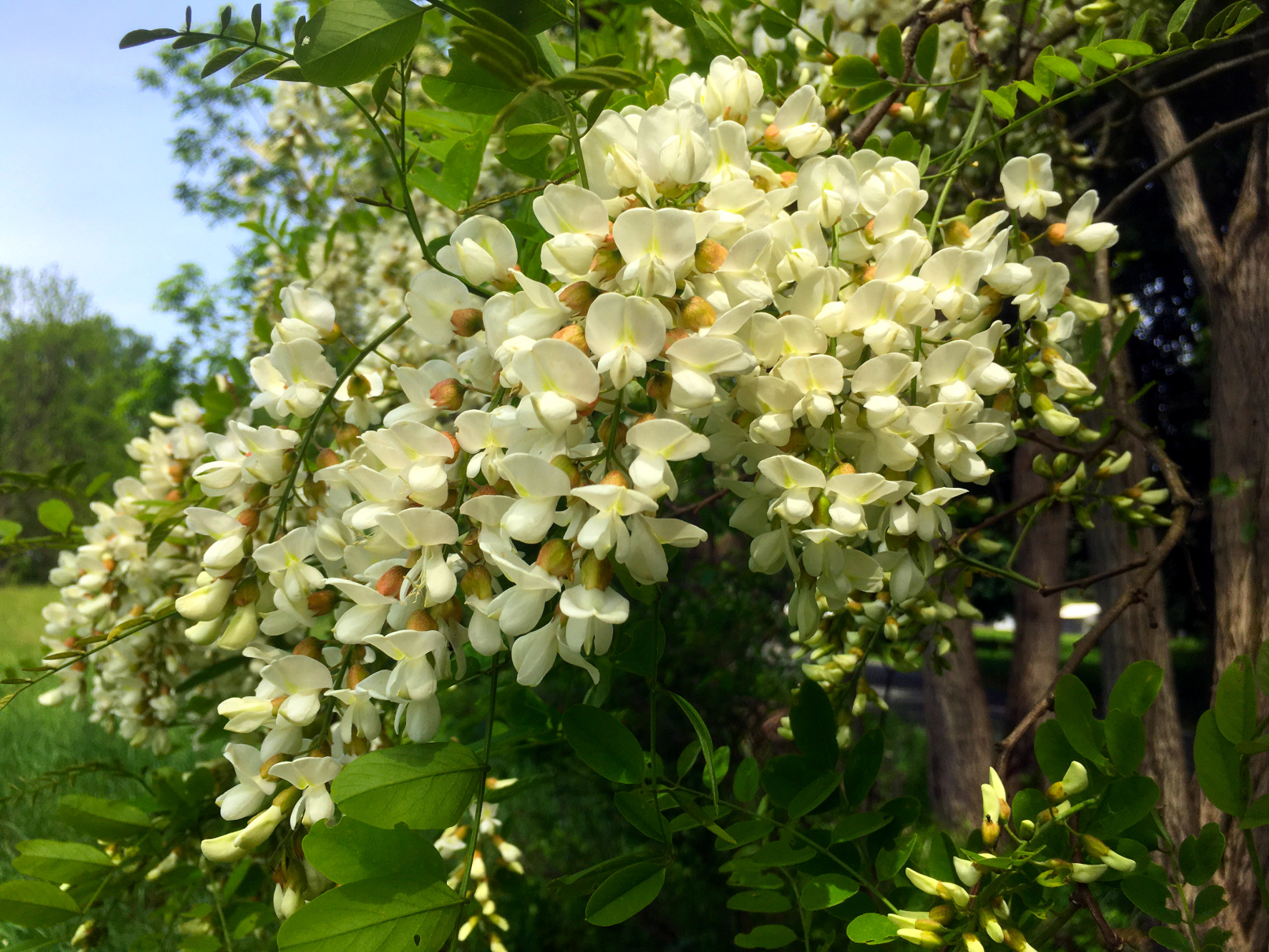
Leaves: Like most legumes, R. pseudoacacia has compound leaves arranged alternately along the branch. Each leaf is composed of at least seven oval-shaped leaflets with smooth margins arranged along the main rib in nearly opposite pairs (Photo 3). Leaflets are normally 1.5 to 2 inches long and 0.5 to 0.75 inches wide.
Seeds/Fruit: Black locust trees produce flat light brown seed pods that can range anywhere from 1.75 to 4 inches in length. The seed pods usually mature sometime in September or October and often remain attached to the tree throughout winter where they become a source of food for wildlife. Once mature, the seed pods frequently crack open to reveal four to eight dry dark brown seeds shaped like kidney beans.
Bark: The bark of R. pseudoacacia varies slightly in color from nearly black in some individuals to lighter shades of orange- or reddish-brown. It appears thick and coarse (especially in more mature trees) with long deep furrows that sometimes spiral around the trunk. There are many who find this to be one of the most readily identifiable features of this species (Photo 3).
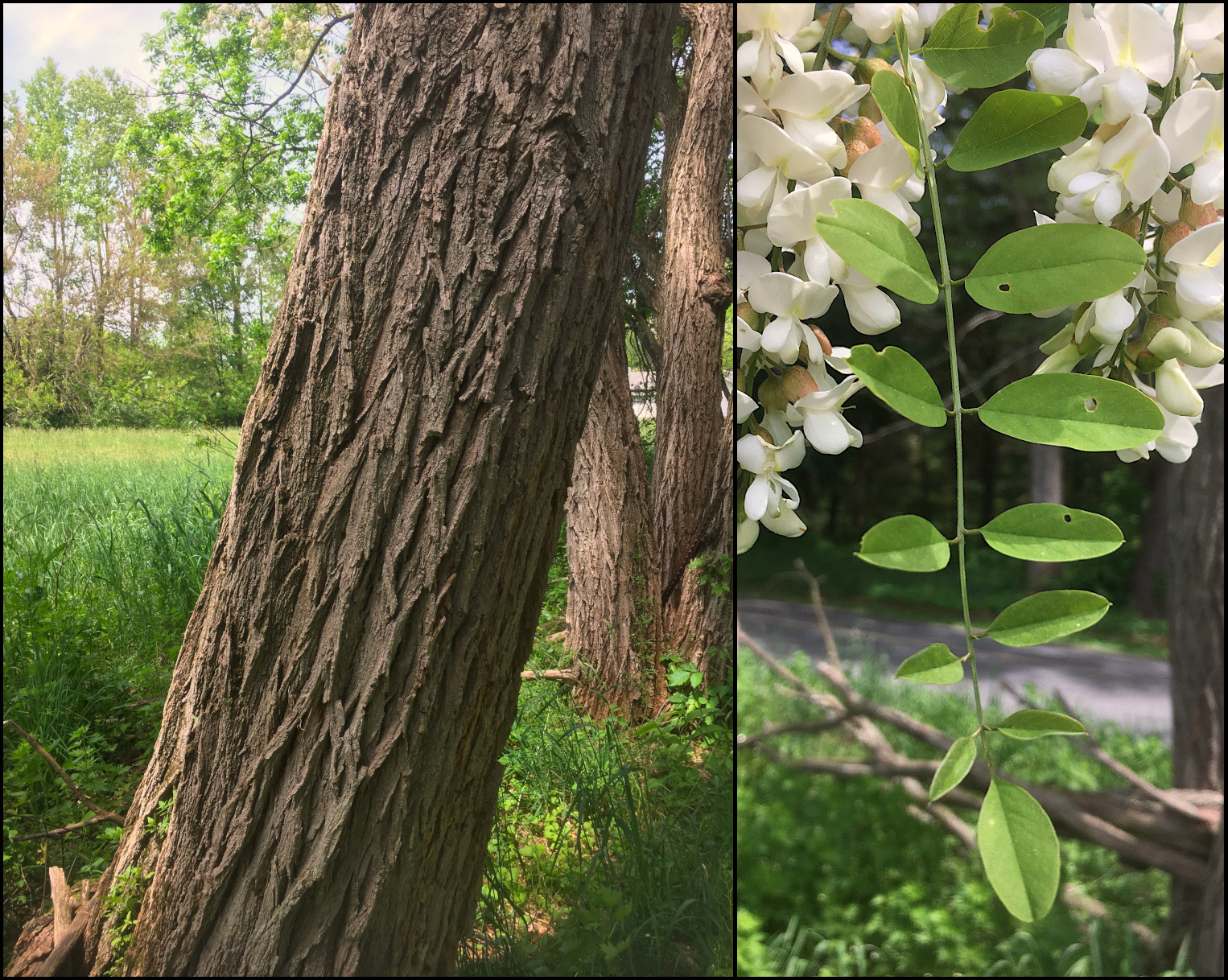
Size: Usually 40-60 feet tall and 1-2 feet in diameter, although some 100-foot specimens have been found.
Distribution: R. psuedoacacia is a cosmopolitan species that has been documented across the continental United States and five other continents. In Michigan, it can be found commonly throughout the lower peninsula and occasionally as far north as Keewenaw County in the upper peninsula. Although biogeographers think its native range was limited to the Appalachia and Ozark mountains, extensive planting by humans has led to its naturalization across the lower 48 states. Black locust is a pioneer species and can thrive in a wide range of soil types and climates. They are often found in ecological transition zones such as riverbanks and woodland edges (Photo 1), as well as areas with frequent disturbance like roadsides, strip mines and farm field edges.
Blooming period: Black locusts typically bloom for about 10 days in late May or early June.
Native status: Native to the U.S. and naturalized in Michigan.
Garden uses: Historically, this species has been very useful for humankind. The durable rot-resistant wood works well for applications such as fence posts, railroad ties and firewood. As with many legumes, black locusts form a mutualistic relationship with nitrogen-fixing bacteria in the soil. This allows the tree to survive (and even thrive) in soil conditions that are less than ideal. It is a relatively fast-growing tree with a shallow spreading root system, making it an excellent choice for erosion control and reclaiming wasteland.
That being said, this species is very aggressive. Although the black locust can reproduce by seed, it has earned a high degree of notoriety for its propensity to send up vegetative shoots from the root system (much like sumacs and poplars). Once a black locust is established in an ecosystem, it is very difficult to eradicate. For this reason, we do not recommend using this tree anywhere near a formal garden setting.
For those who would like more information on how to control unwanted black locust populations, check out the Best Control Practice Guide for Black Locust by the Michigan Department of Agriculture.
Similar species: Honey locust (Gleditsia triacanthos), Bristly locust (R. hispida), Clammy locust (R. viscosa)
Multiflora rose (Rosa multiflora)
Multiflora rose is a deciduous shrub that is an aggressive grower in Michigan. It was first introduced as a solution to soil erosion and as a living fence but has shown highly invasive tendencies. It grows along roadsides and other disturbed sites such as old fields and persists in the understory of forests that succeed from farmland. Multiflora rose reproduces via seed, but also asexually via spreading horizontal stems. The numerous white flowers can be spotted from the road. Up close, the sharp thorns along the stem make themselves apparent and can stop you in your tracks if you run into this species on a walk.
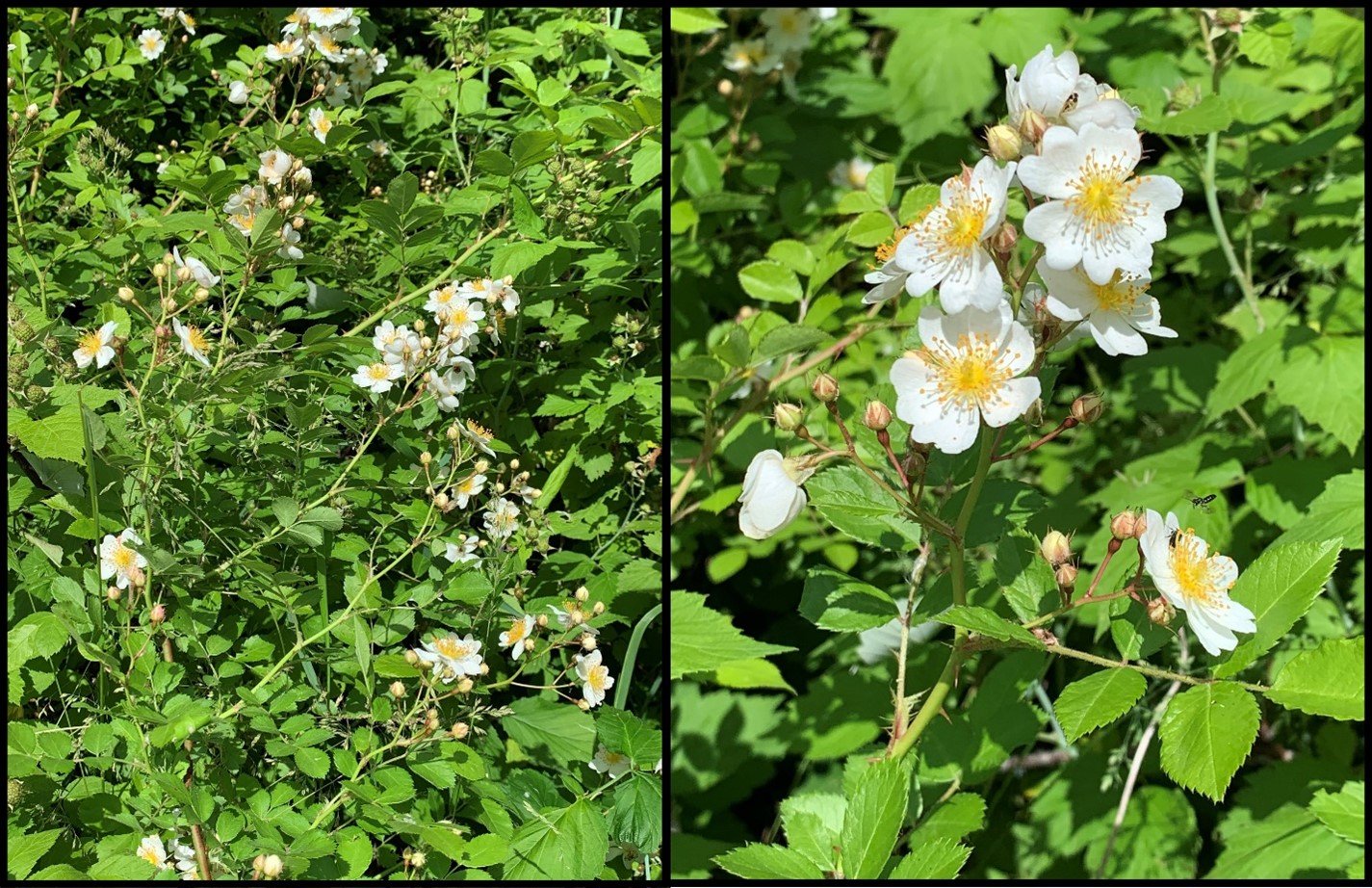
Description
Flowers: Multiflora rose has white (occasionally pink) five-petaled flowers with yellow reproductive parts in the center. Flowers are usually small compared to garden variety roses – about 1.5 inches wide. There are often numerous flowers per plant.
Leaves: The leaves of multiflora rose are pinnately compound and alternately arranged along the stem. There are five to 11 leaflets per leaf. Each leaflet has serrated, or toothed, margins. At the base of each leaf is a finely fringed stipule, which is a quick way to distinguish multiflora rose from Michigan’s native species, which all have stipules that lack fringes.
Quick definition: A stipule is stipule is an outgrowth at the base of a leafstalk (petiole). These growths are usually borne in pairs.
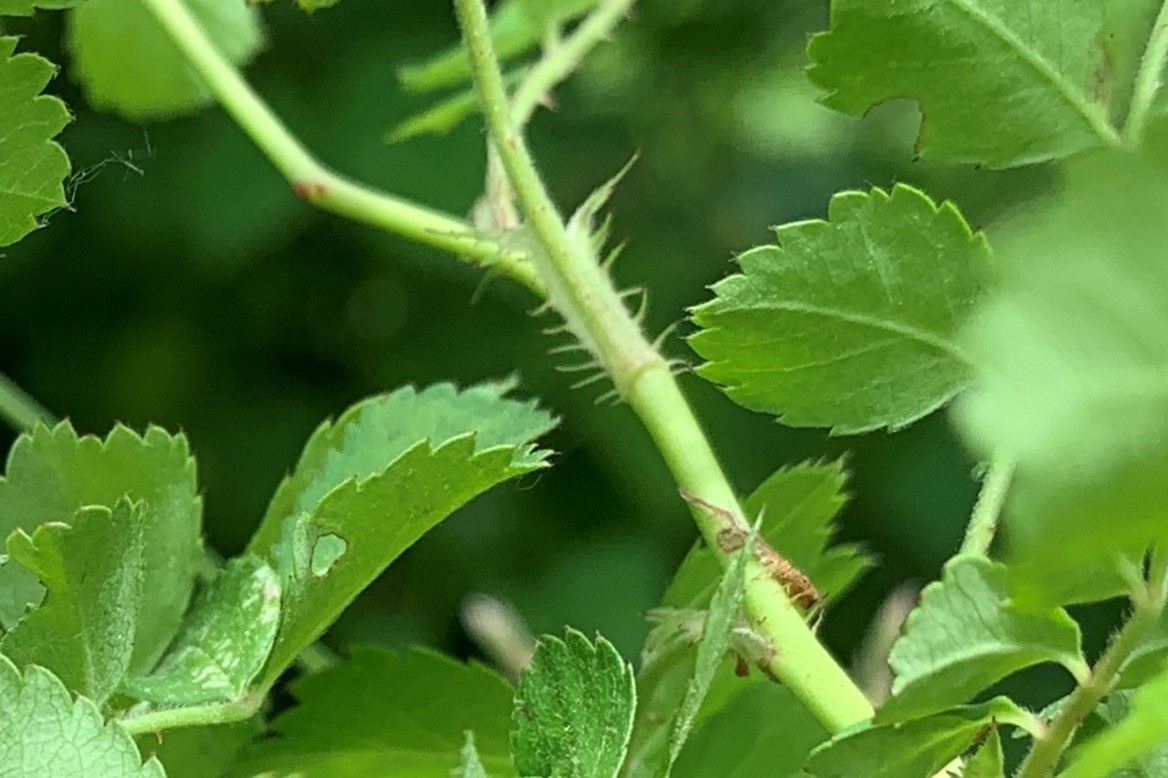
Stems: Multiflora rose stems have sharp, recurved thorns arranged along them. They have an arching growth habit and are green with some hints of red.
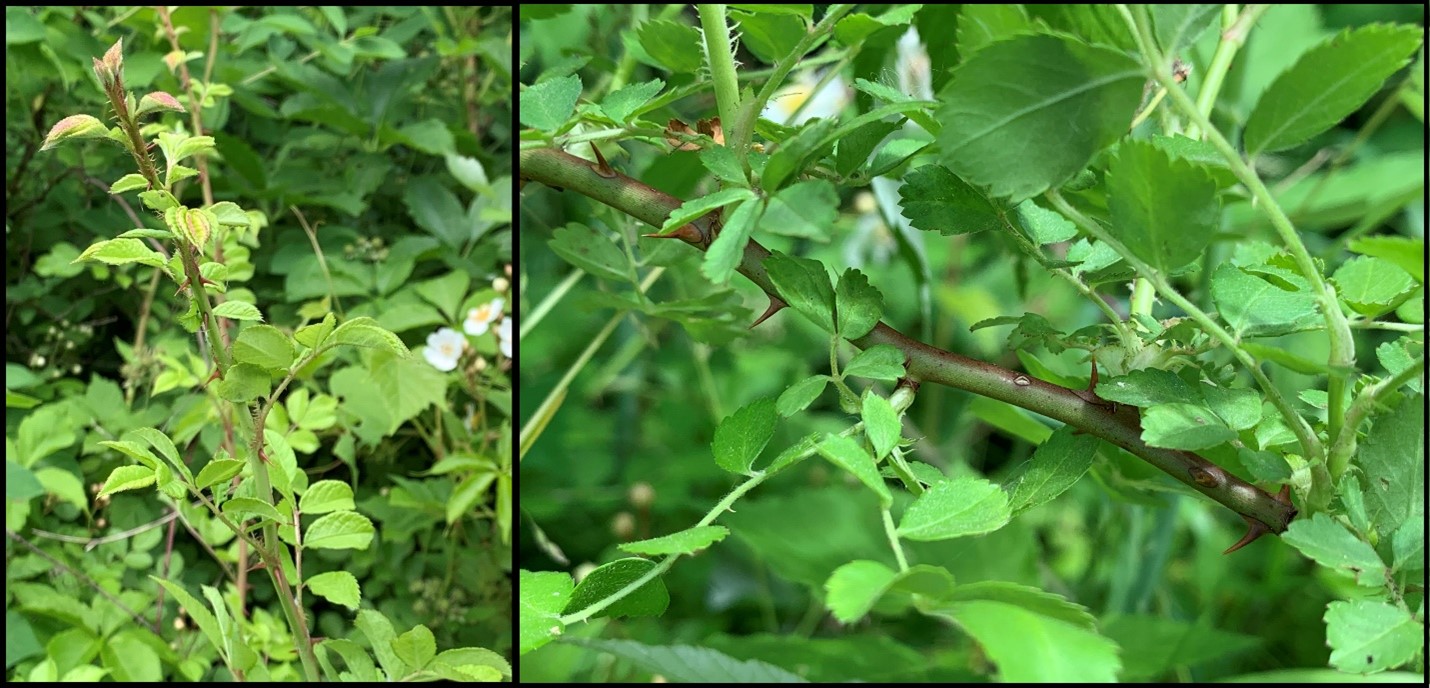
Seeds/Fruit: The fruit of multiflora rose is a characteristic rose “hip.” Botanically speaking, these are pome fruits like an apple or pear. All these species are part of the same family – Rosaceae. Multiflora rose hips are small, red and appear in September to October. They hold yellow seeds that are often dispersed by animals. These seeds can remain viable for 10 to 20 years in the soil seed bank.
Distribution: Multiflora rose has been documented in 35 counties throughout Michigan’s Upper and Lower Peninsulas and likely occurs in many more.
Blooming period: This species blooms from May to June in Michigan.
Native status: Exotic/introduced. This species is not native to the United States.
Garden uses: Multiflora rose should not be used as an ornamental plant in the garden. One native alternative is pasture rose (Rosa carolina). This species does well in dry sites, but you may have to locate a native plant specific nursery to find it. Shrubby cinquefoil (Dasiphora fruticosa, previously Potentilla fruticosa) is another great native alternative. It has long-blooming period and there are many varieties available, including some white-flowered ones such as ‘Happy Face White.’ Shrub roses (Rosa hybrids), which include the Knock Out series, tend to be reliable and there are many to choose from. Japanese beetles can be a problem on these, though.
If you have identified multiflora rose growing, you can report it using the Midwest Invasive Species Information Network (MISIN) website. In order to manage multiflora rose, non-chemical control options are to dig small plants, including all roots, from locations. Repetitive mowing for multiple years before plants can go to seed can also help manage this species. The MISIN website details targeted use of registered herbicides to manage this species as well.
Common look-alikes: There are a few other native rose species that resemble multiflora rose, but these can be distinguished by not having fringed stipules at the base of the leaves. Their flowers are also usually pink and not white.
Want more Drive-by Botany? Check out some of our previous roadside adventures!
- Purple deadnettle and Morrow’s honeysuckle
- Yellow rocket and Dame’s rocket
- Golden Alexanders and Arrowwood viburnum
Questions? Feel free to contact Jeremy Jubenville or Isabel Branstrom with the MSU Extension landscape team.
Thank you to Tyler Bassett from the Michigan Natural Features Inventory for his review of this article.
Resources
- Michigan Flora (2001) – E. Voss
- Trees of Michigan and Upper Midwest (6th edition, 2002) – Norman F. Smith
- Field Guide to Trees of North America (2008) – Kershner, Mathews, Nelson, and Spellenberg
- Sur les jardins botaniques parisiens au XVIe siècle (p. 388) from Journal d'agriculture tropicale et de botanique appliquée, vol. 13 (1966) – Gérard Cusset



 Print
Print Email
Email





